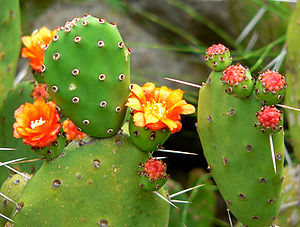Opuntia
| Habit | cacti-succulent |
|---|
|
Opuntia > |
Mill. > |
If this plant info box on watering; zones; height; etc. is mostly empty you can click on the edit tab and fill in the blanks!
Read about Opuntia in the Standard Cyclopedia of Horticulture
|
|---|
|
Opuntia (old Latin name used by Pliny, later used for the Indian fig, probably derived from Opus, a town in Greece). Cactaceae. Succulent plants, a few species of which are extensively cultivated in warm regions for their large, edible fruits, while others are grown as hedges; numbers of species are grown in the collections of fanciers for their oddity. Opuntias vary from small, prostrate plants a few inches above the ground to trees with spreading tops 20 or more ft. high: sts. flat, clavate or cylindrical, bearing more or less elevated areoles, from each of which appears a small caducous pointed If., rarely spreading and foliar; an oval or circular area, more or less covered with soft wool, intermixed with barbed bristles and usually a variable number of spines, occurs in the axil of each If.: fls. borne singly toward the upper part of the joints or sts., on the bristle-bearing part of the areole, and with spreading, showy corollas; the usually many-ovuled inferior ovaries are not of foliar development, and sometimes differ but slightly in appearance from normal sts., usually bristle- and spine- bearing: fr. dry or succulent, frequently edible; seeds large, flattened, discoid and often margined.—There are about 130 species and many varieties and hybrids, extending from Canada southward through the U. S., Mex., W. Indies and Cent. Amer. to the southern part of S. Amer. The species are confined mostly to arid and semi-arid regions; however, some are found in regions of heavy rainfall. They are found in greatest quantity and variety of species in S. W. U. S. and N. Mex., where they are often trees and form the most conspicuous part of the flora. Opuntia is a genus of great variation in habit and appearance, and, from the frequency of natural hybrids and ill-defined specific lines, one of the most difficult genera of flowering plants to present satisfactorily in systematic order. Some of the largest cacti are opuntias, while nearly all that are of economic value belong to this genus. Although the opuntias are less attractive as pol>plants and, on account of their barbed spines and bristles, more difficult to handle than most other cacti, they are coming into favor on account of their unique appearance, rapidity of growth and attractive flowers. They grow best with an abundance of heat and sunlight, the character of the soil being a secondary consideration. Like all other cacti, they require perfect drainage. They are readily grown from cuttings, and also from seed under proper management. Economically considered, the opuntias are by far the most important of the cacti. Although originally confined to the New World, the more important species are now in cultivation or have escaped from cultivation and become wild in every arid and semi-arid region of the globe where the temperature permits then- being grown. Wherever grown, their tendency is to escape from cultivation and become persistent and troublesome weeds. In this respect they are much more to be dreaded in foreign countries than in America, the place of their nativity. As ornamental plants, opuntias are unusual rather than pleasing. From their stiff, formal aspect they do not harmonize, as a rule, with other plants, and on account of their spines and bristles they are difficult to handle and are considered by most gardeners as a nuisance in decorative planting. It is as hedges and as groups of mixed species that they are most effective. Most species grow rapidly and bloom profusely. The flowers, as a rule, are large and showy and of various colors, although yellow predominates. They wither soon after opening and remain at their best only for a few days. The spines and bristles which usually cover the base of the flowers render them of no value as cut- flowers. With many species, such as O. leptocaulis, O. tetracantha, and some forms of 0. Tuna, the bright- colored fruits, which remain on the plants for a long time after ripening, render them more attractive in fruit than in flower. Crested or fasciate forms (Fig. 2596) are common. Although extensively cultivated for their fruit in many countries, where they furnish an important article of diet for four to five months each year, they do not as yet take a pomological rank with the horticulturist, although they are much more widely used and of far more economic importance than many plants which have an established place in pomological literature. From the fact that opuntias nourish best in regions where experimental horticulture receives little or no attention, the development of desirable economic varieties has not been what might be expected of plants which respond so readily to cultivation and selection, and which may be hybridized with so little difficulty. Botanically considered, the fruit is a kind of berry, varying from dry to fleshy and succulent. Morphologically, it is a modified stem with the true seed-capsule sunken into its apex; hence it bears leaves and spines, and usually, under suitable conditions, and frequently in the natural state when it becomes detached, will bud and grow like a normal stem-cutting. Opuntias were cultivated by the aborigines "of America at the time of its discovery, and were early taken by the Spanish explorers to Spain and Spanish colonies in other parts of the world. After becoming established in the Canaries, Azores, and Madeira islands, it was not long before their culture extended to Portugal, Spain, and the whole littoral region of the Mediterranean. From there they spread to Egypt, India, and other parts of southern Asia. In comparatively later times they reached South Africa, ^Australia, and New South Wales, where they are fast becoming a serious menace to agriculture and grazing. In all the regions above noted they have escaped from cultivation and have become pestiferous weeds. The want of fixed characters, the great variations in most species under different soil and climatic conditions, and the readiness with which natural hybrids occur, make the identification of cultivated and introduced species so difficult that the considerable literature on this subject is extremely uncertain as to nomenclature. The common names Indian fig, barberry fig, prickly pear. and tuna, are applied indiscriminately b y most persons to any flat - jointed opuntias, but more particularly to the kinds with edible fruits. The two most widely distributed and extensively cultivated are O. Ficus-indica and 0. Tuna. These plants have often been confused by authors. Much that has been written under the name of one species really applies to the other. They are closely linked together by hybrids, and each has been in cultivation for so long a period that numerous cultural varieties have developed, particularly in Mexico and Sicily. It is possible that the many cultivated forms of both species originated from the same source. Although the Mexicans and Indians eat the fruit of more than a score of indigenous species, the two named above, with their many cultivated forms, are by far the most desirable and palatable. O. Ficus-indica is preferable in most respects to O. Tuna on account of its fewer and smaller spines and usually larger fruit. The latter, however, makes a more formidable hedge, and is more frequently planted in the United States. Hedges of this plant are to be seen at many of the old Spanish missions in Arizona and California, where they were probably first introduced into the United States. O. Ficus-indica is frequently grown by the Mexican population of New Mexico, Arizona, and California. In southern Florida it has escaped from cultivation and become naturalized. The fruits are usually larger and fewer-seeded than in O. Tuna, and are commonly yellow. They frequently measure 3 to 4 inches in length and 2 to 3 inches in width. Forms of this species about the old missions of southern California vary considerably. One form, known as Tuna Colorado, has an insipid, light crimson-colored fruit, while another. Tuna manse, has a yellowish fruit, irregularly mottled with crimson. General cultivation. (D. M. Andrews.) Hardy opuntias satisfy a rather general desire for something unique or grotesque, while at the same time they possess enough ornamental value to recommend them to everyone, and especially to those lovers of cactaceous and succulent plants whose space indoors is limited. Being natives of the western plains and foothills of the mountains, they can scarcely suffer from long-continued drought, and the sunny side of the rockery will suit them exactly, as it will allow all surplus moisture to drain off, and no artificial watering will be necessary. William Falconer, who has used large quantities at Schenley Park, Pittsburgh, Pennsylvania, writes as follows: "In certain localities, as on bleak, exposed banks and about rocky knolls, opuntias and Yucca angustifolia can be used unsparingly with perfect success." He also says, "All have been planted out-of-doors, remaining unprotected summer and winter, and all have been perfectly hardy." They have succeeded also at Kew Gardens, in the very humid climate of England, without protection. Their requirements seem to be as follows: a porous, well-drained soil, a sunny exposure, and a season long enough in which to ripen the fruit and annual growth; these conditions being complied with, they will endure almost any degrees of cold to be experienced even in the most northern portions of the United States. Their altitude- limit in Colorado indicates that they will succeed as far north as Indian corn can be matured. The following kinds have been used successfully, as above indicated: O. arenaria, with small, round to oblong, very spiny joints, the spines varying much in color from gray and straw-color to purplish brown; O. arborescent, the tree or candelabrum cactus, the tallest of this list, is of cylindrical branching growth, with bright purple flowers and yellow fruit; O. Camanchica has very large, orbicular joints, the upper half thickly beset with spines, fruit purple; O. fragilis resembles O. arenaria, but is smaller; O. humifusa includes a multitude of forms, all of which are very hardy; O. phaeacantha var. major is one of the most striking sorts, with immense, glaucous joints, dark purple spines, yellow flowers, and purple fruit; O. polyacantha is one of the most variable, as well as one of the most showy. The spines vary from ivory- white to purple and brown, and from short and stout to long and slender. Nearly all the opuntias have very showy flowers, usually in various shades of yellow and orange. Economic value and cultivation. Two opuntias, O. Ficus-indica and O. Tuna, and possibly a few other closely allied ones, are extensively grown in Mexico. The fruit begins to ripen in June and July, while the later varieties last until December. The fruit is consumed by all classes and conditions of people. The fine bristles which invest the fruit are usually removed before picking by rubbing them with straw, grass or leaves. The fruit is later picked by the hand, or, in some instances, with wooden tongs. In large plantations, when the fruit is raised for commercial purposes, it is usually harvested with a heavy knife, the workman first cutting off the joint bearing the fruit, and later detaching the separate fruits. In preparing the fruit for the table, a thin slice is cut from each end and a slit made through the paring, joining the cut surfaces. The thin paring is easily separated from the mealy but juicy pulp, and quickly removed with the fingers. Today the finest opuntia fruits are grown in Sicily, where they are one of the most important crops that the island produces. From July to November the peasants live almost entirely on this fruit, and considerable quantities are yearly exported to other countries, some of which finds its way to New York and other American cities. It is grown extensively by the Arabs throughout northern Africa, and forms an important part of their food for a portion of each year. The nutritive value of this fruit ranks high, as shown by the following analysis by Wolff: Per cent Dry substance………. 21.60 Ligneous matter…….. 3.70 Proteid substances…. 59 Fatty bodies…………… 1.80 Sugar………………………. 14.00 It has been ascertained that some of the best varieties are capable of producing on lean, sandy or rocky soil, ill-suited for growing ordinary crops, as much as 18,000 pounds of fruit to the acre. When it is considered that this is equal to 2,500 pounds of sugar, as well as other valuable food constituents, it may be readily- seen that the food value from the standpoint of nutrition is considerable. Plantations are usually made on dry slopes of hills, as the plants do not thrive where there is much moisture or on heavy clay soils. Joints, cut or broken from the plants, are used instead of seeds, and are planted at distances of 6 to 8 feet in furrows from 6 to 15 feet apart. No tillage is practised, as they grow rapidly, and in a few years shade and smother out all other growth. Before planting, the cuttings are exposed in half sunlight from seven to fifteen days, that they may partially wither, in order to facilitate rooting. An important advantage in the culture of these plants is the regularity of the yearly crop. They begin to bear in about three years after planting, and continue in bearing for many years. Of the opuntias indigenous to the United States, none as yet has been grown for fruit, or with an effort to improve them. 0. Engelmannii has a large but poorly flavored fruit, rarely eaten, even by the Indians. O. laevis has one of the largest and most palatable fruits of any of the species found growing wild within the United States. This plant also has the advantage of having but few spines. O. Camanchica, O. humifusa, O. chlorotica, O. phaeacantha and O. macrocentra have medium- sized fruits, insipid and unpalatable to the cultivated taste, but eaten by Indians and Mexicans. Wherever grown extensively, the opuntia fruits are used for making a weak alcoholic drink. The juices of the highly colored sorts are sometimes used to color confectionery. Many of the opuntias have considerable forage value, particularly during periods of long drought when other forage crops are short. The range cattle of the southwestern United States feed on either the branches or fruits, or both, of nearly all the indigenous species, the flat stems of O. Engelmannii and the pendulous fruit clusters of O. fulgida being most largely consumed. When cattle are fed largely on unsinged native opuntias, the spines and bristles do great injury. They collect mainly in the mouth, making eating very difficult if not impossible on this account. There are indications that hairballs" composed of opuntia fibers and spicules are likely to be prevalent also under such conditions. In northern Africa the flat joints of the forms with few spines are used as forage for cattle during the dry season, after being allowed to ferment slightly. In Tunis, plantations are sustained by dairymen for the purpose of feeding their cows upon the fleshy stems. Species of opuntia have run wild to a remarkable extent in southern Africa. They have spread rapidly during the past century, and in many places have crowded out the grasses and become a nuisance. Two forms of the plant are recognized by the Dutch fanners; viz., a thorny variety growing on the open country and on stony hillsides known as Doornblad, and a fewer-spined larger variety with thicker stems known as Kaalblad. It is probable that these two varieties originated from the same introduction, for. according to Macdonald, the seed from the Doornblad or Kaalblad variety may give rise to plants resembling either or both of them. It is extensively used as feed for cattle, ostriches and pigs, either alone or when mixed with other forage. Here, however, much harm has come from range cattle eating it in times of little or no other forage, and ostriches become blind from the spines and bristles getting into their eyes in eating the fruits. In New South Wales and Australia, where several species have escaped from cultivation and spread over large areas of arable land and driven out more valuable forage plants, the land has depreciated 50 per cent in value. Here, however, some of the worthless species, such as O. vulgaris and O. monacantha, are more widely spread than the more valuable varieties of O. Ficus-indica and O. Tuna. From what has been said it may be seen, first, that varieties of O. Ficus-indica and O. Tuna produce large crops of edible and nutritious fruits; second, that plants with few or no spines are the general rule in O. Ficus-indica and of not infrequent occurrence in O. Tuna; third, that opuntias are strong, vigorous plants that will grow in situations in which few other plants will thrive; fourth, that spineless forms make valuable forage. With these and more qualities to recommend them, it yet remains for horticultural enterprise to develop a spineless and bristleless variety that will not only be of value for forage but will produce large crops of fruits as attractive to the educated palate as to the savage. From the experience gained in establishing a garden of nearly seventy species and varieties of opuntias, comprising about 300 plants, and watching their growth and behavior for several years, it is thought that they offer great possibilities in the way of improvement in the hands of a careful plant-breeder. In recent years, the prickly pear has attracted considerable attention as forage for cattle. Full report of yields of several species in test plantations in southern Texas is given in Bulletin No. 208 of the United States Department of Agriculture (May, 1915) by David Griffiths. See also a discussion of the forage value of prickly pears by Woodward, Turner and Griffiths, "Journal of Agricultural Research," August, 1915. O. Bergeriana, A. Web. Allied to O. nigricans. Forming a shrub 5-10 ft. high: joints obovate or oblong-ovate, 9 in. long, 4½ in. wide: spines varying in number and size, spreading: fls. red, over 1 in. long. G.C. III. 35:34.—O. cantabrigiensis, Lynch. Similar to O. Engelmannii, but differs in the whitish spines and broadly obconical ovary. G.C. III. 33:98.—O. cervicornis. Probably a hybrid. Joints cylindric, strongly tubercled, decumbent, about 5 in. long: spines golden brown: fls. yellow, 2½ in. wide. Colo.—O. coccinellifera. Mill.—Nopalea.—O. cornigata, Salm-Dyck, was once advertised, but is little known.—O. Deamii, Rose. About 3 ft. high: joints erect or spreading, 10-12 in. long: spines 2-6, stout, white or dull yellow: fls. 3 in. long, rose-colored. Guatemala.—O. Dillenii, Haw. Erect: joints glaucous, obovate-rotundate: areoles clothed with yellow, eventually white, tomentose; spines yellowish, 3-5 smaller ones and stronger: fls. yellow. W. Indies.—O. glaucophylla, Wendl. Erect: joints obovate, glaucous: spines 1 or 2, less than 1 in. long. Mex.—O. Gosseliniana, A. Web. 3-4 ft. high: st. with long bristles. Mex.—O. haematocarpa, Berger, is advertised abroad.—O. haitiensis, Brit. Trunk 10-13 ft. high, densely armed with spines 5 in. or less long: fls. yellow to orange. 1 in. broad. Haiti.-O. Hanburyana, A. Web. Distinct on account of its straggling habit, long spreading spines, small ovary and fr. G.C. III. 35:34.-O. Kleiniae, DC. Shrubby, erect: joints cylindrical, slender: spines mostly solitary: fls. cinnabar-red. Texas.—O. laevis, Coult. Joints light green, elongate-obovate, 12 in. long: areoles small, gray tomentose, with numerous short pale bristles: fls. yellow, tinged with red, about 2 in. broad: fr. somewhat pyriform. Ariz.—-O. lurida is probably O. arborescens.—O. Millspaughii, Brit. Trunk 2 ft. or less high, densely covered with spines sometimes 6 in. long: fls. scarcely ½ in. across. Bahamas.—O. myriacantha, A. Web. Branches yellow-green, pendulous when old: areoles clothed with clusters of yellow bristles: petals pure yellow. Galapagos lab. G.C. III. 27:178.—O. santa-rita, Rose. Joints reddish, usually orbicular: areoles with chestnut-brown bristles: fls. deep yellow, 2½-3 in. across. S. W. U. S.-O. Schumannii, A, Web. Allied to O. nigricans. Shrub, 4-5 ft. high: joints obovate- oblong, 12 in. long, about 5 in. broad: fls. 2H in. long. G.C. III. 35:34.—O. Spegazzinii. A. Web. St. and branches cylindric: spines 5 or 6, short, whitish: fls. small, numerous, white. Paraguay.— O. Taylori, Brit. & Rose. Prostrate, widely branched: joints oblong to narrowly obovate, up to 5 in. long: fls. small, yellow. Haiti.—O. tomentella, Berger. Very free-flowering: joints 8-12 in. long, bright green: areoles clothed with short blackish wool; spines 1 or 2, slender, whitish: fls. yellow-red. Guatemala.—O. tomentosa, Salm-Dyck. Erect: joints lanceolate, 6 in. long: spines bristly, scarcely exceeding the tomentum: fls. reddish. Mex.—O. utahensis, Purpus. Prostrate: joints ascending, elliptic or obovate, swollen, about 6 in. long: areoles circular, with yellowish white wool; spines 1-4, rigid: fls. carmine, up to 4 in. across. Utah.
|
Opuntia, also known as nopales (see below), or Paddle Cactus from the resemblance to the ball-and-paddle toy, is a genus in the cactus family, Cactaceae.
Currently, only prickly pears are included in this genus of about 200[1] species distributed throughout most of the Americas. Chollas are now separated into the genus Cylindropuntia, which some still consider a subgenus of Opuntia. Austrocylindropuntia, Corynopuntia and Micropuntia are also often included in the present genus, but like Cylindropuntia they seem rather well distinct. Brasiliopuntia and Miqueliopuntia are closer relatives of Opuntia.
The most commonly culinary species is the Indian Fig Opuntia (O. ficus-indica). Most culinary uses of the term 'prickly pear' refer to this species. Prickly pears are also known as tuna, nopal or nopales, from the Nahuatl word nōpalli for the pads, or nostle, from the Nahuatl word nōchtli for the fruit; or paddle cactus (from the resemblance to the ball-and-paddle toy). They are native to Mexico.
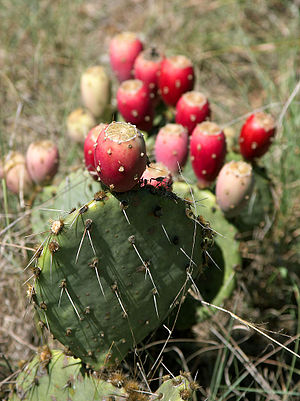
Prickly pear cacti typically grow with flat, rounded platyclades that are armed with two kinds of spines; large, smooth, fixed spines and small, hairlike spines called glochids that easily penetrate skin and detach from the plant. Many types of prickly pears grow into dense, tangled structures.
Like all true cactus species, prickly pears are native only to the Western hemisphere; however, they have been introduced to other parts of the globe.
Opuntia are the most cold-tolerant of the lowland cacti, extending into western and southern Canada; one subspecies, Opuntia fragilis var. fragilis, has been found growing along the Beatton River in central British Columbia, southwest of Cecil Lake at 56° 17’ N latitude and 120° 39’ W longitude.[2] Prickly Pears also give a fruit that is commonly eaten in Mexico, known as "Tuna", also used to make Aguas frescas. The fruit can be red, wine-red, green or yellow-orange.
Charles Darwin was the first to note that these cacti have thigmotactic anthers: when the anthers are touched, they curl over, depositing their pollen. This movement can be seen by gently poking the anthers of an open Opuntia flower. The same trait has evolved convergently in other cacti (e.g. Lophophora).
Read about Opuntia in the Standard Cyclopedia of Horticulture
|
|---|
|
Nopalea (from the Mexican name of the cochineal cactus). Cactaceae. A genus of 4 or 5 species, often placed with the opuntias, but differing from the latter in having erect petals, and stamens and style exsert beyond the perianth, as well as in some minor details. Natives of Trop. Amer. N. coccinellifera, Salm- Dyck (N. inaperta, Schott). An arborescent, flat- stemmed plant, with a somewhat cylindrical trunk 6-10 in. diam., widely grown in semi-tropical countries, but rarely found in the U. S., and then only in the largest collections of cacti. It is chiefly interesting in being one of the important food-plants of the cochineal insect. B.M. 2741. 2742 (as Cactus cochinellifer). N. guatemalensis and N. lutea are 2 recently described species from Guatemala which have been intro. into cult.
|
Cultivation
Propagation
Pests and diseases
Species
Selected species== Opuntia hybridizes readily between species.[3] This can make classification difficult. Also, not all species listed here may actually belong into this genus.

- Opuntia aciculata
- Opuntia anacantha
- Opuntia atrispina
- Opuntia auberi
- Opuntia aurantiaca
- Opuntia basilaris – Beavertail cactus
- Opuntia boldinghii
- Opuntia chaffeyi
- Opuntia chlorotica – Pancake Prickly Pear; native to southwest USA and the Sonoran and Mojave deserts.
- Opuntia clavata
- Opuntia cochenillifera
- Opuntia comonduensis
- Opuntia compressa
- Opuntia curvospina
- Opuntia decumana
- Opuntia decumbens – Nopal de Culebra
- Opuntia dejecta
- Opuntia echios
- Opuntia echios var. gigantea – Galápagos prickly pear. Galápagos Islands.
- Opuntia elata
- Opuntia elatior Mill. – syn. O. bergeriana
- Opuntia engelmannii – Engelmann's Prickly Pear, Cow's-tongue Prickly Pear, Desert Prickly Pear, Discus Prickly Pear, Texas Prickly Pear, calico cactus
- Opuntia erinacea
- Opuntia exaltata
- Opuntia excelsa
- Opuntia ficus-barbarica
- Opuntia ficus-indica – Indian Fig Opuntia
- Opuntia fragilis – Little Prickly Pear, brittle cactus. Found in the Great Plains and as far west as British Columbia.
- Opuntia galapageia
- Opuntia gosseliniana – Violet Prickly Pear
- Opuntia gosseliniana var. santa-rita – Santa Rita Prickly Pear
- Opuntia helleri
- Opuntia hickenii
- Opuntia humifusa – Eastern Prickly Pear (sometimes included in O. compressa)
- Opuntia hyptiacantha
- Opuntia inamoema K. Schum. – quipá
- Opuntia insularis
- Opuntia invicta
- Opuntia jamaicensis
- Opuntia laevis
- Opuntia lasiacantha
- Opuntia leucotricha – Arborescent Prickly Pear, Aaron's beard cactus, semaphore cactus, Duraznillo blanco, Nopal blanco
- Opuntia lindheimeri
- Opuntia littoralis – Sprawling Prickly Pear
- Opuntia longispina
- Opuntia macbridei
- Opuntia macrocentra – Black-spine Prickly Pear, Purple Prickly Pear. Found in southwest USA and northern Mexico.
- Opuntia macrorhiza – Plains Prickly Pear. Found throughout the Great Plains except for the northernmost areas (not found in North Dakota), and extending sporadically eastward as far as Kentucky. Syn. O. leptocarpa MacKensen, O. tenuispina Engelm., O. tortispina Engelm. & Bigelow
- Opuntia maldonandensis
- Opuntia maxima
- Opuntia megacantha
- Opuntia megarrhiza
- Opuntia megasperma
- Opuntia microdasys – Bunny ears cactus, Polka-dot cactus
- Opuntia monacantha – Common Prickly Pear
- Opuntia oricola
- Opuntia ovata
- Opuntia pachypus
- Opuntia pachyrrhiza
- Opuntia phaeacantha – Tulip Prickly Pear. Includes Plateau Prickly Pear, Brown-spined Prickly Pear, Mojave Prickly Pear, Kingman Prickly Pear.
- Opuntia pinkavae – Pinkava's Prickly Pear
- Opuntia polyacantha – Panhandle Prickly Pear. Found in the Great Plains, Great Basin, Mojave Desert, Colorado Plateau, and the Rocky Mountains. Syn. O. rhodantha K.Schum.
- Opuntia polyacantha var. arenaria (syn. O. erinacea)
- Opuntia pubescens (syn. O. pascoensis Britton & Rose)
- Opuntia pusilla – Creeping cactus. Syn. O. drummondii Graham
- Opuntia rastrera
- Opuntia repens
- Opuntia robusta
- Opuntia rufida (sometimes included in O. microdasys)
- Opuntia saxicola
- Opuntia schumannii
- Opuntia soehrensii
- Opuntia stenopetala (syn. O. riviereana Backeb.)
- Opuntia streptacantha
- Opuntia stricta – Erect Prickly Pear, Spineless Prickly Pear, Coastal Prickly Pear
- Opuntia subulata – found in South America
- Opuntia sulphurea
- Opuntia taylori
- Opuntia tehuantepecana – Nopal de Caballo
- Opuntia tomentosa – Woollyjoint Prickly Pear
- Opuntia triacantha
- Opuntia tuna
- Opuntia velutina
- Opuntia violacea
Gallery
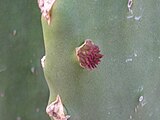
|
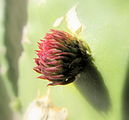
|

|

|
| Bud appears ► | Bud grows ► | Bud grows more► | Bud grows yet more► |
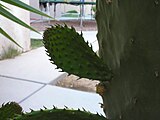
|

|
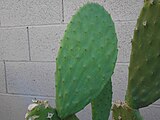
|
| Pad continues growth ► | Edible pad (tender) ► | Mature pad |
References
- ↑ Jon P. Rebman, Ph.D., "What has happened to Opuntia?" San Diego Natural History Museum
- ↑ Cota-Sánchez (2002)
- ↑ Cite error: Invalid
<ref>tag; no text was provided for refs namedgriffith2004
- Standard Cyclopedia of Horticulture, by L. H. Bailey, MacMillan Co., 1963
External links
- w:Opuntia. Some of the material on this page may be from Wikipedia, under the Creative Commons license.
- Opuntia QR Code (Size 50, 100, 200, 500)




